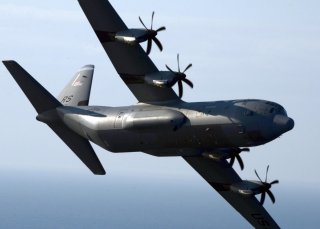The U.S. Air Force Is Prioritizing Laser Weapons Systems
“The whole goal here is to create technological surprise,” Brig. Gen Heather Pringle, Commander, Air Force Research Laboratory, told The Mitchell Institute for Aerospace Studies in a recent video interview.
Here’s What You Need to Remember: The thinking is to first migrate laser weapons to larger aircraft such as C-130 Cargo planes as they fly airframes more likely to succeed in accommodating the on-board power and cooling systems needed to fire successfully. As mobile power and thermal management technology matures, the thinking goes, high powered lasers can arm smaller, high-speed fighter jets.
Lasers, robots, drones, artificial intelligence (AI) and hypersonic attacks are all areas of concentrated focus for U.S. Air Force innovators now looking to introduce a new generation of weapons into current and future warfare.
The Air Force Research Laboratory is accelerating its Science and Technology 2030 Strategy to fast-track innovations to war for the purpose of deploying a new generation of weapons, computing and sensing to future warfare environments.
“The whole goal here is to create technological surprise,” Brig. Gen Heather Pringle, Commander, Air Force Research Laboratory, told The Mitchell Institute for Aerospace Studies in a recent video interview.
The AFRL’s S&T 2030 Strategy, in existence for several years now, seeks to quickly connect promising weapons and technologies with the operational combat community and programmatic acquisition process to succeed in leveraging impactful solutions on a faster time frame.
Pringle told Mitchell that the S&T 2030 Strategy prioritizes “artificial intelligence, autonomy, hypersonics, micro electronics, quantum directed energy and biotechnology. We are supporting technology across the entire Kill Chain, including communications, next generation munitions, and a tradable autonomous platform.”
It would make sense that lasers and AI would figure prominently, given that the Air Force is fast approaching a point at which it might be able to fire precision-guided laser weapons from drones or even fighter jets. The challenge, scientists explain, is to generate the requisite amount of exportable electrical power in a small enough form factor to sustain a powerful aircraft-fired laser. Thermal management is also crucial when it comes to lasers as temperature needs to be properly regulated and controlled to ensure successful operation of the weapon.
Lasers are a useful example because they represent what could be referred to as an interesting threshold between “in-development” weapons systems and those which are arriving or have arrived. Lasers are evolving along a certain significant trajectory, because many are already deployed and operational, yet newer kinds of more impactful applications are fast emerging at the same time.
The Army, for instance, wants to engineer laser weapons strong and compact enough to integrate onto a mobile vehicle for expeditionary operations on the move. The service is already seeking to add more kilowatts to its Stryker-mounted laser weapon, refine drone-intercepting lasers for base defense and even explore laser optics for dismounted soldiers maneuvering to contact with an enemy.
The Air Force Research Laboratory has for many years now been ground-testing and refining laser weapons systems, in preparation for arming aircraft and eventually fighter jets.
The thinking is to first migrate laser weapons to larger aircraft such as C-130 Cargo planes as they fly airframes more likely to succeed in accommodating the on-board power and cooling systems needed to fire successfully. As mobile power and thermal management technology matures, the thinking goes, high powered lasers can arm smaller, high-speed fighter jets. The Navy already deploys laser weapons on ships. In fact, years ago, an Office of Naval Research-developed system called the Laser Weapons System was deployed on the USS Ponce, a development which continues to pave the way forward toward more powerful and extensive laser weapons applications aboard ships.
Along these lines, the Navy is already working with the Missile Defense Agency to “power scale” lasers with the intent of possibly even using them for ballistic missile defense. Weapons developers say it is by no means beyond the realm of the possible for laser weapons to reach into space to counter threats traveling beyond the earth’s atmosphere.
Kris Osborn serves as Defense Editor for The National Interest. He previously served at the Pentagon as a Highly Qualified Expert with the Office of the Assistant Secretary of the Army - Acquisition, Logistics & Technology. Osborn has also been an anchor and on-air military analyst for national TV networks.
This article is being republished due to reader interest.
Image: Flickr.

